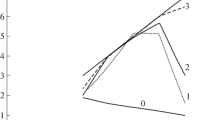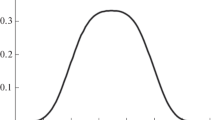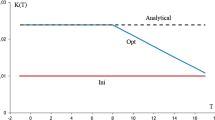Abstract
The problem of determining the temperature-dependent thermal conductivity coefficient is studied. The study is based on the Dirichlet boundary value problem for the two-dimensional nonstationary heat equation. The cost functional is defined as the rms deviation of the temperature field from experimental data. For the numerical solution of the problem, an algorithm based on the modern fast automatic differentiation technique is proposed. Examples of solving the posed problem are given.
Similar content being viewed by others
REFERENCES
O. M. Alifanov and V. V. Cherepanov, “Mathematical simulation of high-porosity fibrous materials and determination of their physical properties,” High Temp. 47 (3), 438–447 (2009).
O. M. Alifanov, Inverse Heat Transfer Problems (Mashinostroenie, Moscow, 1988; Springer, Berlin, 2011).
P. N. Vabishchevich and A. Yu. Denisenko, “Numerical methods for solving inverse coefficient problems,” in Methods of Mathematical Modeling and Computational Diagnostics (Mosk. Gos. Univ., Moscow, 1990), pp. 35–45 [in Russian].
A. A. Samarskii and P. N. Vabishchevich, Numerical Methods for Solving Inverse Problems of Mathematical Physics (Nauka, Moscow, 1997; de Gruyter, Berlin, 2007).
A. A. Samarskii and P. N. Vabishchevich, Computational Heat Transfer (Wiley, New York, 1996; Editorial URSS, Moscow, 2003).
V. I. Zubov, “Application of fast automatic differentiation for solving the inverse coefficient problem for the heat equation,” Comput. Math. Math. Phys. 56 (10), 1743–1757 (2016).
Yu. G. Evtushenko, Optimization and Fast Automatic Differentiation (Vychisl. Tsentr Ross. Akad. Nauk, Moscow, 2013) [in Russian].
Yu. G. Evtushenko and V. I. Zubov, “Generalized fast automatic differentiation technique,” Comput. Math. Math. Phys. 56 (11), 1819–1833 (2016).
Yu. G. Evtushenko, E. S. Zasukhina, and V. I. Zubov, “Numerical optimization of solutions to Burgers’ problems by means of boundary conditions,” Comput. Math. Math. Phys. 37 (12), 1406–1414 (1997).
A. F. Albu and V. I. Zubov, “Investigation of the optimal control of metal solidification for a complex-geometry object in a new formulation,” Comput. Math. Math. Phys. 54 (12), 1804–1816 (2014).
A. F. Albu and V. I. Zubov, “On the efficient solution of optimal control problems using the fast automatic differentiation approach,” Tr. Inst. Mat. Mekh. Ural. Otd. Ross. Akad. Nauk 21 (4), 20–29 (2015).
A. F. Albu, Y. G. Evtushenko, and V. I. Zubov, “Identification of discontinuous thermal conductivity coefficient using fast automatic differentiation,” Lect. Notes Comput. Sci. 10556, 295–300 (2017).
A. A. Samarskii, The Theory of Difference Schemes (Nauka, Moscow, 1989; Marcel Dekker, New York, 2001).
ACKNOWLEDGMENTS
This work was supported by the Russian Foundation for Basic Research, project no. 17-07-00493a.
Author information
Authors and Affiliations
Corresponding author
Additional information
Translated by I. Ruzanova
Rights and permissions
About this article
Cite this article
Albu, A.F., Zubov, V.I. Identification of Thermal Conductivity Coefficient Using a Given Temperature Field. Comput. Math. and Math. Phys. 58, 1585–1599 (2018). https://doi.org/10.1134/S0965542518100032
Received:
Published:
Issue Date:
DOI: https://doi.org/10.1134/S0965542518100032




